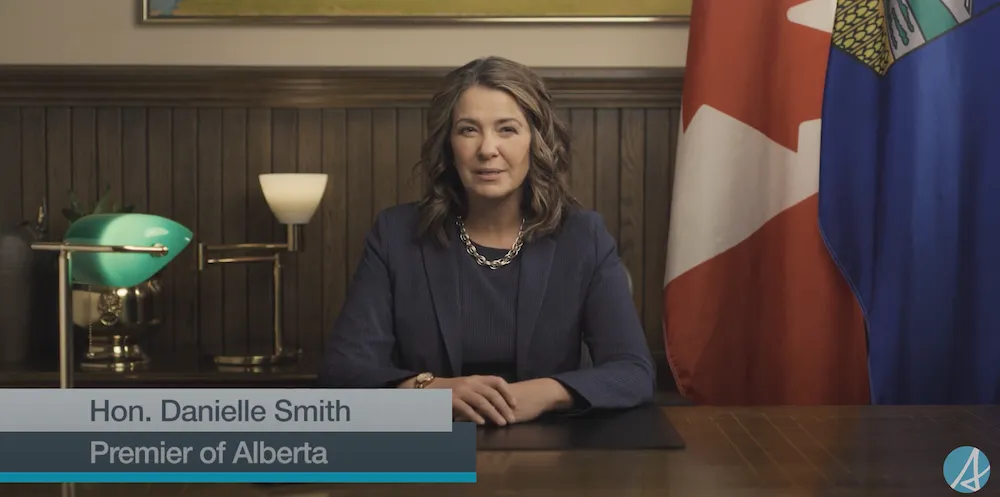It was 1975 and Lougheed’s PCs were swimming in oil money like Scrooge McDuck
The Heritage Savings Trust Fund was front and centre in Premier Danielle Smith‘s pre-budget televised speech last week, so there’s a good chance Albertans are going to hear a lot about it when Finance Minister Nate Horner rises in the Legislative Assembly this afternoon to table the provincial government’s annual budget.
In her 8-minute address to Albertans, Smith said she wants to funnel oil and gas royalty revenues into the Heritage Savings Trust Fund to increase it to between $250 and $400 billion by 2050. A report to the Standing Committee on the Alberta Heritage Savings Trust Fund reported the fund had a market value of $21.6 billion in 2023.
Many Albertans know the patriotic version of the Heritage Savings Trust Fund story – a visionary rainy day bank account created in the 1970s by former premier Peter Lougheed meant to preserve Alberta’s oil wealth for future generations. But like many political stories that reach legendary status it is missing a lot of relevant historical context.
Read the rest on the Daveberta Substack.
Sign up for a paid subscription to get access to the Daveberta Podcast and special Alberta politics extras.
- Tags 2024 Alberta NDP Leadership Race, Adriana LaGrange, Alberta Budget 2024, Alberta Heritage Savings Trust Fund, Alberta NDP, Anaida Poilievre, Brian Jean, Corb Lund, Danielle Smith, Daveberta Substack, David Climenhaga, David Parker, Don Braid, Gil McGowan, Gordon Miniely, Grant Notley, Harry Strom, Janet Brown, Jenni Byrne, Jodi Calahoo Stonehouse, Max Fawcett, Nate Horner, Perry Bellegarde, Peter Lougheed, Pierre Poilievre, Sarah Hoffman, Scooge McDuck, Take Back Alberta, Tyler Gandam, United Conservative Party, Werner Schmidt
Supporters of the Alberta Liberal Party will gather virtually this weekend for the party’s annual general meeting two years after the party was shut out of the Legislative Assembly for the first time in more than three decades.
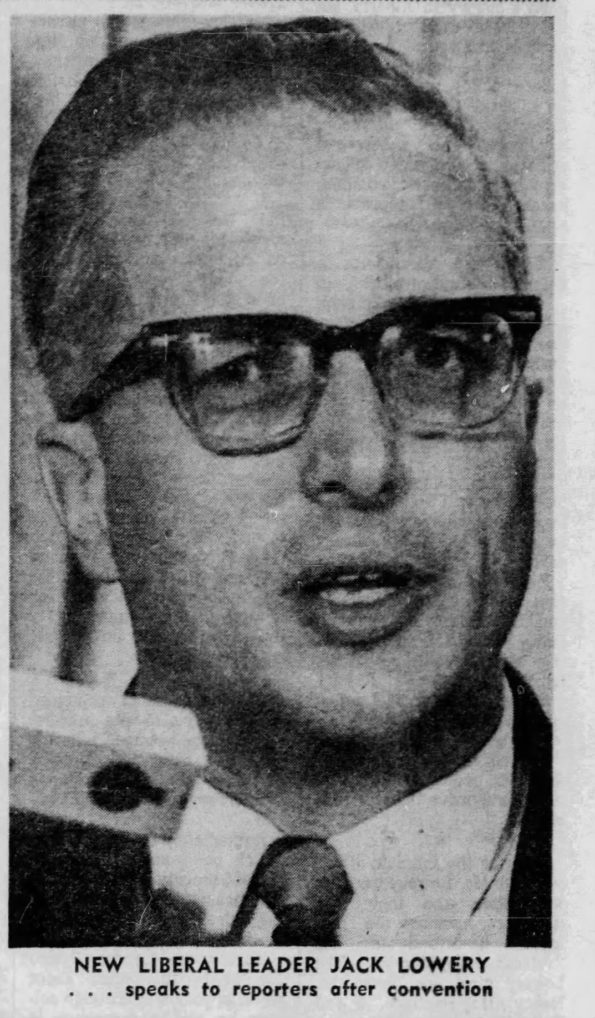
This year also marks 100 years since the Liberal Party lost the 1921 election to the United Farmers of Alberta after governing the province since it was founded in 1905.
The Liberals formed the official opposition for most of the period from their defeat until the 1967 election, when the Progressive Conservatives led by Peter Lougheed knocked the Liberals to third place in the Legislature.
As the Liberals ponder what it means to be a seatless party in 2021, I took a look back at what happened the last time the Liberals were shut out of the Legislature.
The 1967 election marked the Liberal Party’s poorest showing in decades, and death, defection and resignation would mean the party’s three MLA caucus would not survive the full term.
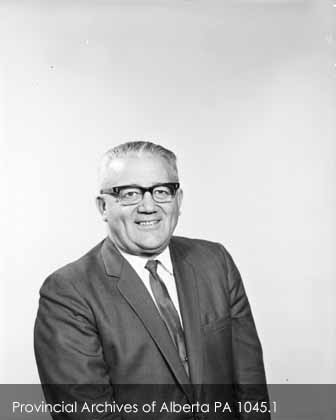
Party leader and Lac La Biche MLA Michael Maccagno resigned his seat in early 1968 to run in the federal election and later formally resigned as leader in October 1968. Edson MLA William Switzer died of a heart attack in June 1969. And in November 1969 the party’s sole remaining caucus member, Calgary-Glenmore MLA Bill Dickie, crossed the floor to join Lougheed’s PC Party.
The party was on the decline and faired poorly in the by-elections to replace Maccagno and Switzer, with Liberal candidates finishing third in Lac La Biche and fourth in Edson.
But that was not where this story of the Alberta Liberal Party’s ends.
Former United Church Minister Jack Lowery, who preached at Calgary’s Southwood United Church without collecting remuneration so he could work full-time as the public relations manager for ATCO Industries Ltd., was chosen as leader on April 26, 1969.
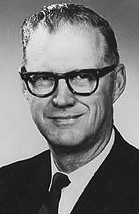
He was also the chief statistician for the Calgary Stampeder Football Club, where he led a team of analysts and technicians who tracked the CFL team’s performance. It is no wonder that Calgary Herald’s Johnny Hopkins described him in 1967 as someone who simply couldn’t find enough activities to fill all his waking hours.
With none of the party’s MLA entering the leadership race, Lowery defeated Town of Manning Mayor Don Branigan (who would later become Mayor of Whitehorse in Yukon), future party leader Bob Russell, and 20-year old University of Alberta political science student Trevor Midgley (who entered the race 8 minutes before the nomination deadline).
The 39-year old Lowery moved to Alberta after graduating from theology school in Toronto to serve churches in the Hardisty area and described himself as an “issues-oriented pragmatist” with a left-orientated slant on social development philosophy and “small conservative” financial ideas.
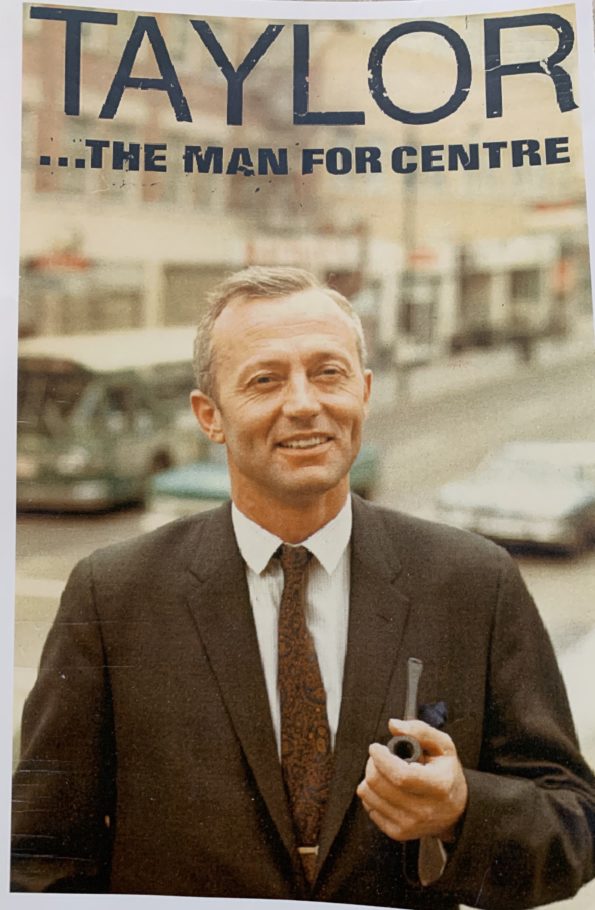
This was Lowery’s second foray into elected politics, having just the previous year mounted an unsuccessful campaign against oilman and school board trustee Nick Taylor for the federal Liberal nomination in Calgary-Centre (Taylor would go on to lead the Liberals back into the Legislature in 1986).
“It’s been said for a long time that there are those in the Liberal Party who have had a vested interest in defeat,” Lowery told Calgary Herald for the “Personality of the Week” column on May 30, 1969.
“They’ve been quite happy to go directly to Ottawa without having to work in a party structure that could go somewhere. All of these people will be encouraged to become party of the team,” Lowery said.

Lowery was an outsider who inherited the leadership of a deeply divided and cash poor party that was overshadowed by a flashier and increasingly unpopular federal Liberal Party led by Prime Minister Pierre Elliott Trudeau.
He was the Liberal Party’s third leader in five years following the resignation of Adrian Berry after nine months as leader in 1966 and the return of Maccagno as leader for a second time before Lowery was chosen.
Early on in his leadership he dismissed the chances of Lougheed’s PCs and pledged to reestablish the Liberals as the alternative to the long-governing Social Credit Party, which he described as “very long on promises and short on implementation.”
The decision by MLA Dickie to join the Lougheed PCs in November 1969 because of what he described as “leftist philosophy” in the Liberal Party meant the party no longer had any representation in Legislature.
“This merely clears the decks so that we can do the kind of building we’ve been wanting to do. I do not agree with him that we have a leftist philosophy,” said Lowery in response his Dickie’s defection.
But it all really started to unravel for Lowery when was revealed the next month that he had reached out to Social Credit Premier Harry Strom to either merge or create an electoral alliance between the two parties.
His fate was sealed.

“We can run candidates in the traditional sense in the next election. We can stand aside and let the Social Credit and Conservative partiee fight it out, or we can work with Social Credit to determine areas of mutual interest,” Lowery told the Calgary Herald on Dec. 30, 1969.
“We are 10 years away from being an effective political force and some form of coalition in which the Liberal party would retain its identity is one of the alternatives open,” Lowery said.
Calgary-South Liberal Member of Parliament Pat Mahoney, a former President of the Calgary Stampeders Football Club, said the idea should be pursued with an open mind.
“The Alberta Liberals have been unfairly burned by the identification with Ottawa and the necessity of supporting federal policies,” Mahoney told the Calgary Herald. “They have a right to pursue an independent course.”
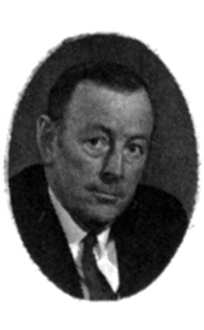
But Mahoney’s federal colleague from Edmonton had a different opinion. Edmonton-Strathcona Liberal MP Hu Harries called the proposal “bloody nonsense” and predicted it will not receive support from the Alberta Liberals membership.
Harries called on Lowery to resign and described talk of a Liberal-Socred alliance as a “selfish, stupid reaction to a complete failure” that was the Liberal Party’s inability to win the by-elections to replace the party’s former MLAs.
Prominent Edmonton Liberal and well-known publisher Mel Hurtig described the idea as absurd and clashed with Lowery at a party meeting in January 1970.
“Liberals are not people who are concerned with developing deals where they sell out their principles,” Hurtig was reported to have said.
Lowery defended his position by arguing that the merger discussions with the Socreds had “provoked interest and has given us an opportunity to delineate what we stand for as Liberals.”
But Harries and Hurtig were not alone. Constituency association presidents from across the province revolted against the idea – and Lowery.
And despite Lowery’s optimism, Strom’s own public response poured cold water on the entire idea of a Socred-Liberal alliance.
“We would be prepared to welcome those members of the Liberal party or any other party, who wish not join and work with us, but we are not at all interest in any deals or mergers,” Strom said.
The other opposition parties took it as an opportunity to welcome disaffected or confused Liberals into their camps.
Alberta New Democratic Party leader Grant Notley said his party would open wide the doors for disgruntled Liberals who wish to join “a genuine alternative to the conservative consensus of the Socreds and Tories.”
And Lougheed said any move toward a Liberal-Socred alliance would benefit his PC party.
“The last provincial election and the last two by-elections indicate that the majority of liberal-inclined voters would prefer to see a new progressive government in Alberta end 35 years of Social Credit control,” Lougheed said.
On February 16, 1970, only 10 short months after winning the leadership, Lowery resigned as leader of the Alberta Liberal Party.
He was replaced by the third-place finisher from the previous year’s leadership contest, Bob Russell.
A year later, Lowery re-emerged into the political spotlight to publicly announced he had left the provincial Liberals and was joining the Social Credit Party. He was soon after named the coordinator of the party’s Calgary campaign for the 1971 provincial election.
When the votes were counted on August 30, 1971, Lougheed’s PC Party had unseated the Socreds to form the first new government in Alberta since 1935. It was a political earthquake from which the Socreds would never recover.
And the Liberals remained shut out of the Legislature. The party’s vote dropped to 1.01 per cent and no where in Alberta did a Liberal candidate come close to winning election.
The Liberals would remain in the electoral wilderness in Alberta for the next 15 years.
(For more history about Liberal Party in Alberta during the 1960s and 1970s, check out Darryl Raymaker’s excellent book, Trudeau’s Tango. Alberta meets Pierre Elliott Trudeau).
- Tags Adrian Berry, Alberta Liberal Party, Alberta NDP, Alberta PC Party, Alberta Social Credit Party, ATCO, ATCO Industries Ltd., Bill Dickie, Bob Russell, Calgary Stampeders, Calgary-Centre, Calgary-Glenmore, Calgary-South, Darryl Raymaker, Don Branigan, Edmonton-Strathcona, Edson, Grant Notley, Harry Strom, Hu Harries, Jack Lowery, Johnny Hopkins, Lac La Biche, Michael Maccagno, Nick Taylor, Pat Mahoney, Peter Lougheed, Trevor Midgley, Trudeau’s Tango. Alberta Meets Pierre Elliott Trudeau, United Farmers of Alberta, William Switzer
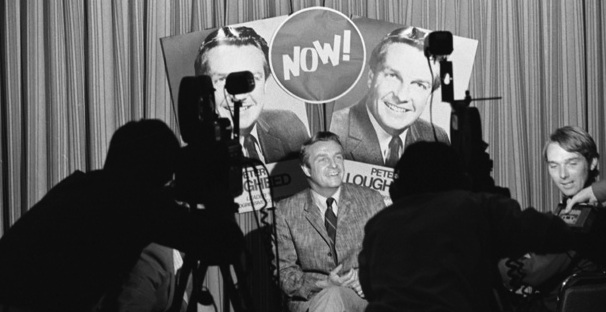
On August 30, 1971, the Progressive Conservative Party led by 43-year old Calgary lawyer Peter Lougheed were rocketed into government when they unseated the 36-year old Social Credit government led by 57-year old Harry Strom.
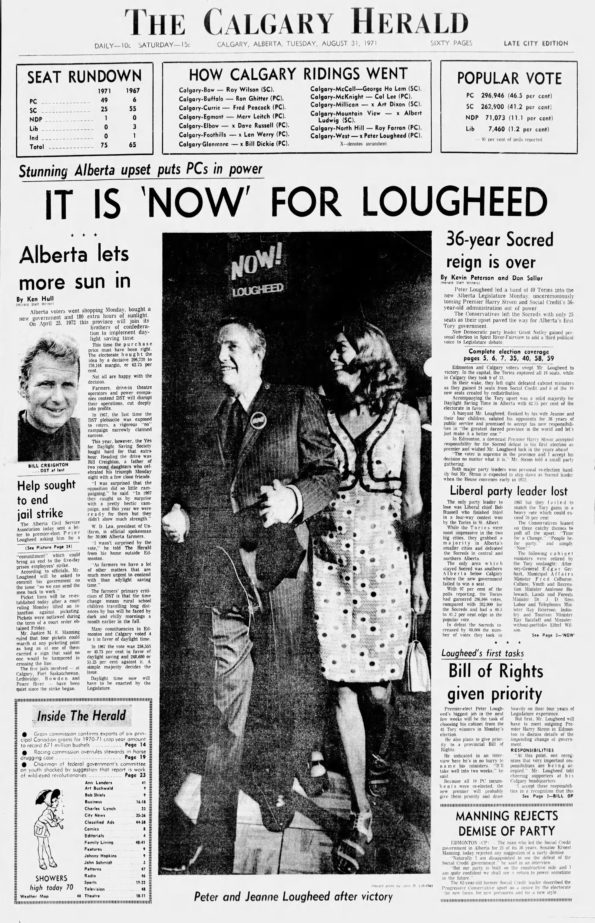
It was a shift that, until recently, had happened only once every generation in Alberta: a change in government.
Lougheed’s election represented a generational shift, with the voting age dropping from 21 to 18 years old for the first time, and an urban shift, with a handful of new urban districts added to the electoral map dislodging the disproportionate rural majority that had dominated Alberta’s elections until that point.
As Ernest Manning’s successor, Strom inherited an aging dynasty that had governed Alberta since 1935. While he appeared open to new ideas, modernizing the long-in-the-tooth Socred government was a tall order.
In contrast, Lougheed embodied new ideas of a younger Alberta – or at least that’s what the mythology of that election tells us. His campaign was made for TV and the telegenic Lougheed could be frequently seen “main streeting” and running from door to door while canvassing for his party’s candidates.
Social Credit tried to revitalize their look, with go-go girls and live bands at their election rallies, but once voters decided that change was needed it was impossible for Strom to turn that around. And the iconic NOW! slogan of Lougheed’s campaign tapped into that feeling.
The Lougheed PCs were not alone. They had the financial backing of corporate Calgary, including generous support from the Mannix Corporation, which employed Lougheed before he was first elected to the Legislature in 1967.
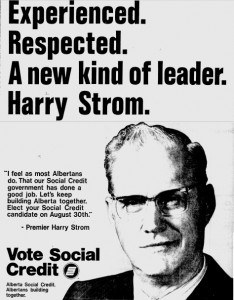
The PCs won with 49 seats and 46.4 per cent of the popular vote, sweeping out Social Credit, which, with 25 seats and 41.1 per cent of the vote formed the Official Opposition for the first time. While the Social Credit Party would wither in the opposition benches and eventually shrink into a 4 MLA rump that would survive until the early 1980s, Lougheed’s first victory transformed Alberta politics for the next five decades.
The PCs would form commanding majorities until their defeat to Rachel Notley’s New Democratic Party in 2015.
Also elected in 1971 was NDP leader Grant Notley, who would represent the northern rural district of Spirit River-Fairview until 1984. The NDP narrowly missed out electing a few other MLAs in this election, and Notley would remain the party’s only MLA – and the only social democratic voice in the Legislature – until Ray Martin was elected in Edmonton-Norwood in 1982.
The Alberta Liberal Party, which had formed Official Opposition before Lougheed’s PCs earned the spot in 1967, were wiped off the political map and would remain in the political wilderness until 1986.
In politics timing is everything, and Lougheed lucked out. Massive windfalls in oil and gas revenues led to overflowing government coffers, allowing the PC government to make major investments in public infrastructure like hospitals, schools, universities and colleges. The Lougheed PCs founded the The Banff Centre, the Kananaskis Country recreation area, and even bought an airline – Pacific Western Airlines.
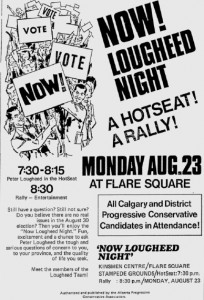
Lougheed’s government introduced a Bill of Rights, created the Legislature Hansard, and dissolved the notorious Alberta Eugenics Board.
The difference between Lougheed and some of his successors in Alberta’s Conservative dynasty was his belief that government had a positive role to play in society (a Reform Party Member of Parliament named Jason Kenney once criticized Lougheed’s legacy of “neo-Stalinist make-work projects.”)
Lougheed believed Alberta should behave like an owner of our oil and gas resources and that the government should collect its fair share of revenues. Royalty revenues were much higher than today, peaking at 40 per cent during his time as Premier. The oil companies complained but Lougheed was persistent.
“This is a sale of a depleting resource that’s owned by the people. Once a barrel of oil goes down the pipeline it’s gone forever. It’s like a farmer selling off his topsoil,” Lougheed once said.
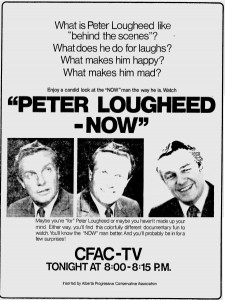
Lougheed’s government also negotiated landmark financial investments from the federal government and the Ontario government in the oil sands that kickstarted development of the deposits when private investors would not take the risk. These government investments in Alberta’s oil industry likely helped save companies like Suncor when the international price of oil plummeted in the 1980s.
Relations between Lougheed’s government and Ottawa soured following the introduction of the National Energy Program, creating a political wedge that Conservative leaders have continued to crank ever since. But he always made sure he was seen as advocating for Alberta in a strong Canada and was a key player during the Constitution-making negotiations of the early 1980s.
The Heritage Savings Trust Fund is one of Lougheed’s biggest legacies. Today the trust fund is seen as a visionary move to save money for future generations of Albertans, which it is in a way, but it was also a result of a government that at one point literally had more money that it knew what to do with.
Lougheed commanded the loyalty of his cabinet, caucus and party – which built a political dynasty that would span four decades but also gave him a bit of an autocratic reputation.
PC MLAs would be required to share frequent local membership and fundraising updates with the Premier’s Office and Lougheed was known to make monthly calls with local PC Party association presidents in order to create a system of accountability with his local leaders. And there have also been stories that Lougheed kept undated and signed letters of resignation from his cabinet ministers in order to avoid having to fire anyone who became a political liability.
There is a Camelot-like mythology to Lougheed’s time in office. He towers over Alberta politics in ways that more recently popular leaders like Ralph Klein do not. While Klein was a populist, Lougheed was a builder. The oil money sure helped, but so did having a vision for making this province a better place.
Day Light Saving Time Referendum
Nothing is new under the prairie sun. In 1971, Albertans voted to adopt Daylight Saving Time in a province-wide referendum after voting against DST in a 1967 referendum. This October 2021, Albertans will vote whether to abandon the time change and permanently adopt Daylight Saving Time.
Newspaper Election Ads from 1971
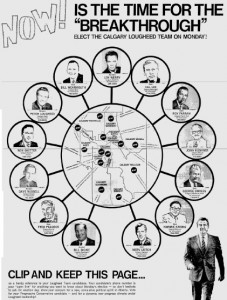
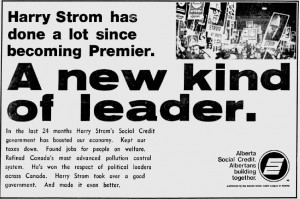
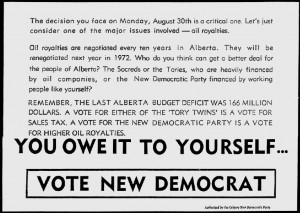
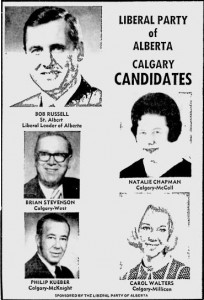
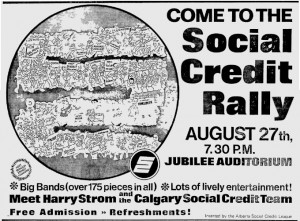
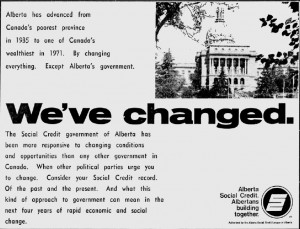
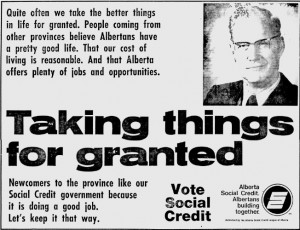
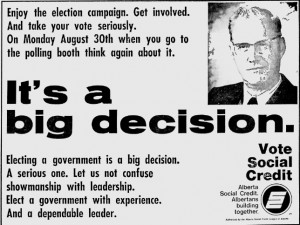
- Tags 1971 Alberta Election, Alberta Heritage Savings Trust Fund, Alberta Liberal Party, Alberta NDP, Alberta PC Party, Alberta Social Credit Party, Daylight Saving Time, Edmonton-Norwood, Ernest Manning, Grant Notley, Harry Strom, Jason Kenney, National Energy Program, Peter Lougheed, Rachel Notley, Ralph Klein, Ray Martin, Spirit River-Fairview

Political party fundraising totals from 2019 were released last month and show that Alberta’s two main provincial parties raised record amounts of money last year.
The United Conservative Party raised $7.37 million as the party continues to demonstrate its fundraising strength. The now official opposition New Democratic Party also raised an impressive $5.5 million.
The total amount of donations raised by the two main parties is significant, especially when you consider how much Alberta’s political parties were raising five years previous. In 2014, the formerly governing Progressive Conservative Party raised $3,387,585.83, and the then fourth place NDP marked a record fundraising year with $482,085.
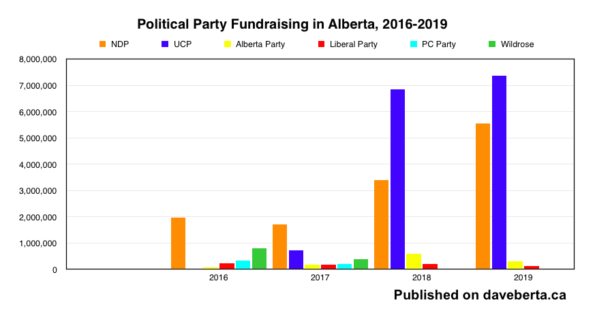
Both the NDP and the UCP’s successor predecessor party, the Wildrose Party, spent years cultivating strong bases of individual donors, which meant they were well positioned when corporate and union donations were banned in 2015.
The disclosures suggest that despite losing the election, the NDP remained a financially viable political party in the second half of 2019. The annual fundraising totals for the NDP in 2020 will provide some evidence as to whether the now official opposition party can sustain its fundraising levels outside of government.
Likely to help the NDP’s fundraising efforts in 2020 is Rachel Notley’s decision to lead the party into the next provincial election.
Notley would become the first former Alberta premier to lead their party into an election after they lost government. With Alberta’s long history of political dynasties, there are only a few premiers who had led their parties to lose an election – Charles Stewart, Richard Reid, Harry Strom, and Jim Prentice all resigned following their party’s election defeats.
Not having led a dynastic party, and arguably remaining her party’s strongest asset, Notley is in a different position than some other former premiers. She remains personally popular, and some early polls would suggest her party could remain an electoral force if a vote were held today.
The NDP faces a number of significant challenges, one being its lack of organizational strength in much of rural Alberta and Calgary. The NDP elected 24 MLAs in 2019, but none from rural Alberta and the party lost considerable ground in Calgary, where it had a breakthrough in 2015.
A positive note for the provincial NDP is that attempts to connect Notley to the federal NDP, which has been demonized in Alberta for its opposition to oil pipeline projects, does not appear to have hurt its fundraising bottom line.
But while the lack of federal party presence in Alberta is a mixed blessing for the NDP, it is a strength of the UCP, which shares considerable resources with its federal cousins in the Conservative Party of Canada. The upcoming federal Conservative leadership campaign could also introduce an interesting dynamic into this relationship (more on this comings soon).
The Other Parties
Alberta’s smaller political parties raised considerably less that the big two parties in 2019, with the Alberta Party raising $317,470, the Liberal Party raising $130,519, the Green Party raising $27,999, and the Freedom Conservative Party raising $24,783.
The Alberta Party remains leaderless following Stephen Mandel’s resignation shortly after his defeat in the 2019 election. It is suspected that the party will open a leadership race in the spring, after the UCP government is expected to make significant amendments to Alberta’s electoral finance laws, including rules for leadership races.
Mandel and his predecessor Greg Clark have been appointed to positions by the UCP government. Mandel now serves on the board of directors of Alberta Health Services and Clark is now chair of the province’s balancing pool.
David Khan‘s leadership was “overwhelmingly endorsed” by delegates attending last year’s Liberal Party convention, despite 2019 marking the first time since before 1986 that the party failed to elect any MLAs to the Legislative Assembly.
Delegates to the convention heard from a party committee that was convened to offer recommendations for how the Liberals should move forward in Alberta. The report was not made public.
Green Party members will vote for a new leader on March 28, 2020, following the resignation of Cheryle Chagnon-Greyeyes in 2019. Brian Deheer and Jordan Wilkie have declared their candidacies. This will be the party’s third leadership race since 2017.
The Green Party also announced plans to adopt a co-leader system in which two individuals will share leadership responsibilities. This is the first party in Alberta to use a system similar to Green parties in other countries and Quebec solidaire in Quebec.
Alberta’s separatist fringe gets fringier
And there continues to be a flurry of activity on the separatist fringe.
Former UCP nomination candidate Dave Campbell has replaced former UCP nomination candidate Todd Beasley as President of the Independence Party of Alberta. The party currently does not have a leader.
Meanwhile, Kathy Flett, who is styled as the former interim leader of the Wexit Alberta separatist group, has joined the board of directors of the right-wing Freedom Conservative Party, which was founded in 1999 as the Alberta First Party and has at various times changed its name to the Separation Party of Alberta, the Western Freedom Party, and again to the Alberta First Party.
It could be that the Freedom Conservative Party is about to change its name once again, this time to the Wexit Alberta Party, or maybe the fringe separatists are continuing to fraction?
According to the Western Standard, a conservative website rebooted by former Freedom Conservative Party leader Derek Fildebrandt after his defeat in the 2019 election, current federal Wexit leader Peter Downing claimed he fired Flett for attempting “to steal our trademark.”
- Tags Alberta First Party, Alberta Liberal Party, Alberta NDP, Alberta Party, Brian Deheer, Charles Stewart, Cheryle Chagnon-Greyeyes, Dave Campbell, David Khan, Derek Fildebrandt, Freedom Conservative Party of Alberta, Green Party of Alberta, Green Party of Alberta Leadership Race 2020, Greg Clark, Harry Strom, Independence Party of Alberta, Jim Prentice, Jordan Wilkie, Kathy Flett, Peter Downing, Rachel Notley, Richard Reid, S. Todd Beasley, Separation Party of Alberta, Stephen Mandel, United Conservative Party, Western Freedom Party, Wexit, Wexit Alberta
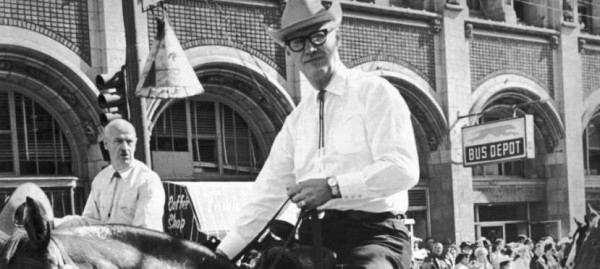
Billed as the Greatest Outdoor Show on Earth, the Calgary Stampede is a must-stop destination for political leaders of all stripes and all levels of government. The event also provides a good historical marker of how quickly the political winds of change can sweep through Alberta.
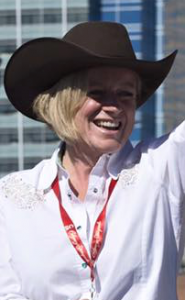
One year ago at last year’s Stampede, Dave Hancock was Premier of Alberta, Jim Prentice was an unstoppable candidate in the Progressive Conservative leadership race, the memory of Alison Redford was fresh in the minds of Albertans, Danielle Smith led the Wildrose Official Opposition, the Alberta Party was still on the fringe, and the NDP were in the midst of a leadership race many political watchers saw as a sideshow.
Now to this year’s Stampede, Rachel Notley is Premier of Alberta and there are 53 NDP MLAs in the Alberta Legislative Assembly (including 15 from the Calgary area), a former Member of Parliament named Brian Jean leads the Wildrose Official Opposition, former Calgary alderman Ric McIver leads a 9-MLA PC Caucus, Alberta Party leader Greg Clark is an MLA, and Mr. Prentice has disappeared from the political landscape.
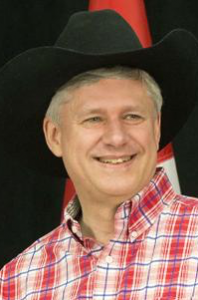
The changes that took place between the two Stampedes are an important reminder about how quickly political change can happen, even in a province that is known for turning political parties into governing dynasties.
With the October 19 federal election less than four months away, it is also an important reminder to Conservative Prime Minister Stephen Harper that even voters in the Canadian conservative movement’s spiritual homeland cannot be taken for granted. That thought must have crossed Mr. Harper’s mind as he met with Ms. Notley for the first time this week in Calgary.
The provincial election win has boosted the NDP’s credibility and organizational strength, especially in Edmonton, but it is not clear how this will translate in the federal election. Ms. Notley’s win has created opportunity for the federal NDP in Alberta, especially for candidates like Janis Irwin in Edmonton-Griesbach and Linda Duncan in Edmonton-Strathcona. As Tom Mulcair‘s federal NDP focus their resources in Quebec, Ontario and British Columbia, it is to their advantage to put the Conservatives on the defensive in Alberta, a situation that has not happened very often.

Meanwhile, Liberal leader Justin Trudeau has reason to be optimistic after his party’s candidate’s came close to winning by-elections in Calgary-Centre in 2012 and Fort McMurray-Athabasca in 2014. The Liberals have also nominated a slate of high profile candidates that includes Kent Hehr in Calgary-Centre, Darshan Kang in Calgary-Skyview and Amarjeet Sohi in Edmonton-Mill Woods.
The Conservatives are still expected to hold most of Alberta’s ridings in the upcoming federal election but the NDP and Liberals could make gains in the major urban centres.
The truth is that federal Conservatives have always taken Alberta voters for granted, and they have had reason to. Albertans have not elected more than 2 non-conservative MPs in any federal election since 1993. The Conservatives even held all 28 of the province’s federal ridings between 2006 and 2008.
With a federal election fast approaching and and increasingly stale government approaching ten years in Ottawa, the Conservatives may need to spend more time campaigning in Alberta in the next few months, or else there could be a whole new cast of federal politicians wearing plaid shirts and cowboy boots at next year’s Calgary Stampede.

How badly do the Progressive Conservatives need to mess up for Albertans to want to elect an NDP government? It may sound like a silly question in the context of Alberta politics, but we might find an answer on May 5.
Judging by the more than 1,500 Albertans who showed up at an NDP rally in Edmonton yesterday, the momentum behind Rachel Notley‘s NDP is real.
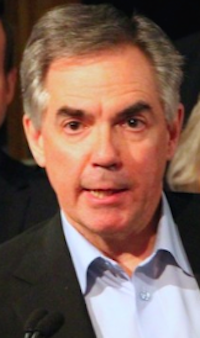
“I think the PC Party needs a break from government and Albertans need a break from the PC Party,” Ms. Notley told the massive crowd at the Ramada Hotel on Kingsway Avenue. “You don’t have to repeat history on Tuesday, you can make history,” she said.
Legions of Albertans tired of Jim Prentice‘s long-governing PC Party have rallied around the NDP in this election. With the confident Ms. Notley at its helm and a moderate Lougheed-like platform, the NDP campaign in this election has been near flawless. With exception of a few bumps, including a fiscal miscalculation that was quickly fixed and one candidate’s past praise of former Venezuelan President Hugo Chavez, the NDP machine has run smoothly.
In contrast, the PC campaign has appeared distant, robotic and fraught with controversy. The latest controversy has forced Mr. Prentice to call for a review of MLA expenses. Metro Edmonton uncovered the expenses last week, which included one Edmonton PC MLA who expensed $12,500 for a Christmas Party.
‘The PCs sound, in fact, like Social Credit Premier Harry Strom, the one they beat in 1971,’ wrote Calgary Herald columnist Don Braid. Albertans young enough to have voted in the last election are at least 65 years old, meaning that most voters will not remember the last time we had a change in government in Alberta, 43 years ago.
Mr. Prentice wanted this election to be about his spring budget, but Albertans appear to have decided this election is about trust and acceptability, two areas where the PCs have a poor track record.
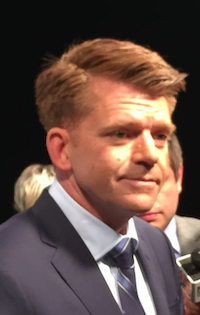
Standing in the crowd at the NDP rally, I spoke with two senior citizens who were very excited to experience their first political rally. It is also the first election they will vote NDP. They voted for the PCs in the last election and in many elections before that, they told me.
If the Orange Chinook is real, what will the results look like on election night?
Most media coverage since the leaders’ debate has focused on the NDP and PC parties, but outside of the major urban centres, Brian Jean‘s conservative Wildrose Party is expected to be a big factor. You only need to take a quick drive outside Edmonton City Limits and you will immediately notice the campaign signs change from NDP orange to Wildrose green.
The PCs have placed third behind the NDP and Wildrose parties in most recent polls, but it would be foolish to predict a that party’s defeat even with only on day left in the election campaign. After 43-years in government, the PC Party Establishment is pulling out all the stops to ensure it wins re-election, including its recent fear campaign against the NDP.
It is also important to remember that the constant stream of polls showing the NDP leading the Wildrose and PC parties might not necessarily be reflected in the number of MLAs elected in our first past the post system (as we saw in the 2012 election when the Wildrose Party earned 34% of the province-wide vote and only 19% of the seats in the Assembly).
If a party’s support is too concentrated in one area of the province, it may win seats but not enough to form a majority government. And if a party’s support is too thinly spread across the province, it could be shut out.
On May 5 we will find out if Albertans are ready to take a break from the PC Party and embrace an Orange Chinook. It could be Alberta’s most interesting election night in 43 years.
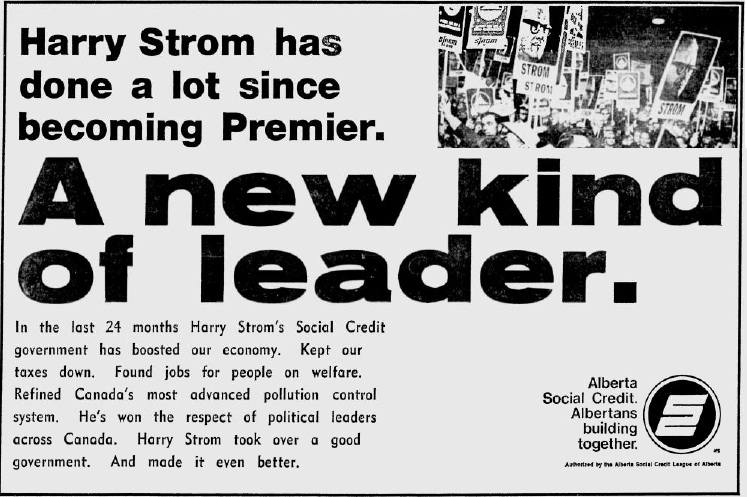
As the Progressive Conservatives brandish their new slogan, “A new era for Alberta,” many Albertans might be confused about which political party has been in power for the past 43 years.
The Oxford English Dictionary defines an era as “a long and distinct period of history.”
If we were to apply the geological time scale of the Earth to Alberta politics, we would now find ourselves in the Honeymoon Period of the Prentice Era of the Progressive Conservative Eon (I will resist the temptation to name any political dinosaurs).

And despite the PC Party Eon having stretched more than four decades, PC Party candidates in four Alberta by-elections being held on October 27 are not running on their party’s record as the government since 1971. They are running on their party’s record since Jim Prentice became leader of the PC Party on September 6, 2014.
And it is too early to tell whether Mr. Prentice will oversee “a long and distinct period.” His two most recent predecessors each lasted less than five years in office.
The PC Party’s “new era” slogan is somewhat reminiscent of another slogan used by Harry Strom‘s Social Credit Party as the 36 year old governing party tried, albeit unsuccessfully, to win re-election in 1971. But, unlike the Socreds in the 1970s, the PC Party has become masterful at reinvention, consistently rebranding their party since Peter Lougheed retired in 1984.
Unlike Mr. Strom, who was overshadowed by his popular and larger than life predecessor, Ernest Manning, Mr. Prentice would never be caught in public uttering the words “Alison” or “Redford.” But while the PC Party tries to put their recently departed leader’s legacy behind them, the opposition parties and candidates will eagerly remind voters about the past two years of PC government.
Just two years ago, the PC Party led by Alison Redford were re-elected in a hotly contested campaign under the slogan “Real life leadership” (see the campaign advertisement above). This slogan was a reference to both Ms. Redford’s time spent overseas as a United Nations lawyer and provided contrast with her predecessor, Ed Stelmach, and the perceived inexperience of Wildrose leader Danielle Smith.
During the 2012 election campaign, a controversial advertisement published in some urban newspapers featured the slogan “Not your father’s PC Party,” which suggested to younger and more liberal-minded Albertans that the PC Party had entered a new era (and again provided a contrast to the perceived social conservative values of the Wildrose Party).
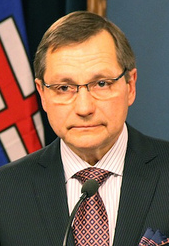
Six years ago, borrowing from the success of Barack Obama‘s “Change we can believe in” slogan, the PC Party led by Mr. Stelmach chose “Change that works for Albertans” as their slogan in the 2008 election. The slogan suggested that Mr. Stelmach’s main opposition, the Liberals, would provide change that would not work for Albertans.
Like his successors, the PC Party under Mr. Stelmach worked hard to distance itself from the legacy of his predecessor, Ralph Klein.
In the four by-elections being held at the end of October 2014, the opposition parties are also using new slogans to help brand their campaigns. “Send the PCs a message” is a slogan being used by the Wildrose Party, and it is meant to remind Albertans that by-elections are an opportunity to show dissatisfaction with the PC Party’s past two years of scandal and misdeeds.
The NDP are using the slogan “Albertans deserve better,” which is a true statement, but it seems unlikely that most Albertans outside Edmonton city limits are about to look to the NDP as a better choice.
While slogans alone will not win or lose an election campaign, they can cleverly help define the narrative each party or candidate is advancing and can serve as a rallying cry for or against voters choosing change at the ballot box.
If you have a few moments after reading this post, I encourage you to take a glance at the extensive ‘List of Political Slogans‘ page on Wikipedia.
- Tags A new era for Alberta, Alison Redford, Barack Obama, Calgary-Elbow by-election, Calgary-Foothills by-election, Calgary-West by-election, Change that works for Albertans, Change we can believe in, Changing with Albertans, Danielle Smith, Ed Stelmach, Edmonton-Whitemud by-election, Geological Time Scale, Harry Strom, Jim Prentice, Not your father's PC Party, Peter Lougheed, Ralph Klein, Real life leadership, Social Credit Party
Social Credit celebrates 77 years in government.
- Post author By Dave Cournoyer
- Post date November 9, 2012
- 7 Comments on Social Credit celebrates 77 years in government.
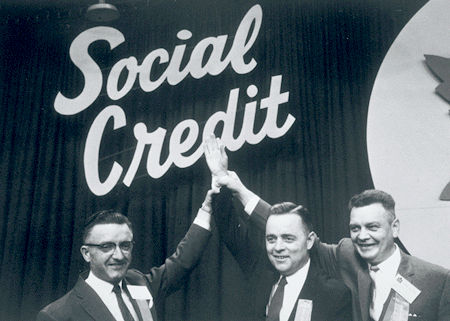
CALGARY STAR-TRIBUNE
In 1935, Fred Astaire and Ginger Rogers’ hit song “Cheek to Cheek” topped the music charts and the Winnipeg Blue Bombers became the first western Canadian team to win the Grey Cup. It was also the year that the Social Credit Party formed government in Alberta.
Fresh from celebrating the party’s 21st consecutive election win, Premier Rob Anderson will join party faithful this weekend to celebrate the Social Credit Party’s 77th year in government.
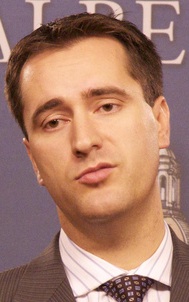
“One of the regular talking points of the Official Opposition is to claim that after 77 years of Socred rule, the province of Alberta is some grim, dark, horrible place to live,” said Premier Anderson. “It’s entirely untrue, of course. And it doesn’t say much for the Opposition that they say such terrible things about this great province.”
“Alberta is the best place to live, work and play in Canada,” said the Premier.
On Friday night, Premier Anderson will join Traditional Family Values Minister Rob Anders, Telecommunications Minister Ezra Levant and Treasurer Jason Kenney in paying tribute to former Premiers William Aberhart, Ernest Manning, Harry Strom, Preston Manning, Stockwell Day, and Monte Solberg.
Only once in the party’s 77 year history has it faced the threat of electoral defeat.

While the history books record Premier Harry Strom as the great conciliator of Canadian confederation, he led the dynasty to its narrowest victory the 1971 election. New to the office, Strom fought back young Peter Lougheed‘s liberal-minded Progressive Conservatives, leading his party to form a small majority government.
Four years later, Strom led Social Credit to a decisive victory over the Tories.
Many historians credit Social Credit’s survival in 1971 to the failure of the Daylight Savings Time plebiscite.
Lingering in the opposition benches in the 41 years since 1971, the PC Party has been unable to topple the long-standing government.
Current PC Party leader Raj Sherman has called the Social Credit Party old and out of touch.
“The simple fact is that over the past 77 years the government has backed itself into a corner on revenue and desperately needs to find a way to return to solid financial ground,” said Sherman, an emergency room doctor.
“While Albertans deserve to have a say in all matters of public policy, I am troubled by this administration’s penchant for government by polling – particularly when they are so selective about the feedback that they choose to heed,” said Sherman.
NDP leader Rachel Notley has called on Premier Anderson to tear down the economic “Firewall” that divides Alberta from the rest of Canada. “Too often the Socreds make poorly studied, reactionary decisions based on industry lobbying”, said Notley.
“As things stand now, we are closing our eyes, crossing our fingers, and hoping for the best,” Notley said. “Albertans deserve better,” said Notley.
Albertans can follow the weekend’s celebrations using the Twitter hashtag #after77years.
tory attack ad tame by all standards.
- Post author By Dave Cournoyer
- Post date March 8, 2012
- 21 Comments on tory attack ad tame by all standards.

Alberta’s political twitterati were atwitter yesterday after a Progressive Conservative radio advertisement was leaked to the Calgary Herald. The ad defend the new law passed by Premier Alison Redford‘s government that will lower a driver’s legal blood alcohol level from 0.08 to 0.05 and respond to the constant, and sometimes creative, criticism of the new law by Danielle Smith and her Wildrose Party.
Judging by the amount of earned media the Tories have already received about the yet-to-be-aired ad, the ad may have already paid for itself.
Unlike the negative ads saturating the airwaves in the Republican Party presidential nomination race south of the border, this Tory radio ad is very, very tame. The ads point out a clear difference between the two parties on a real policy issue that both parties believe they have something to gain from.
Albertans should expect high levels of sensationalism from mainstream political pundits in over the course of the next week. How many times can we expect the phrase “the gloves off” to be used in the next few days? Lots.
The Tory Party’s shift in tactics is important to note. Calgary Herald columnist Don Braid points out on his blog that the ad marks an attitude change in a PC Party that would typically dismiss the opposition (and romp to another election victory).
Normally invulnerable, the Tories may be worried that accusations and evidence of intimidation and bad governance may be starting to stick. The growing pile of Tory political miscalculations and mistakes are starting to pile up with an election call expected by the end of March.
Some of the latest Tory missteps include Dunvegan-Central Peace MLA Hector Goudreau’s threatening letter to school board officials in his constituency, the war of words between Municipal Affairs Minister Doug Griffiths and Alberta Urban Municipalities Association President Linda Sloan, and the ensuing tweet of Premier Redford’s now-former Chief of Staff Stephen Carter. Along with Elections Alberta announcing an investigation into allegations of illegal political donations.
Yesterday, the Canadian Taxpayers Federation released information showing that 21 MLAs, mostly Tories, are being paid $1000 per month for being members of a legislative committee that has not met in over three years. Lacombe-Ponoka PC MLA Ray Prins has been collecting $18,000 a year for being the chair of the committee.
Bonnyville-Cold Lake PC MLA Genia Leskiw pleaded ignorance when asked about the extra money she was collecting from the committee, telling the CBC that “I don’t even look at my paycheque.”
Maybe the Tories should be worried.
As the Spring 2012 provincial election approaches, the Progressive Conservatives and Wildrose Party have rolled out a series of television ads (on YouTube) delivering their political pitches to Albertans.
The Wildrose ads, as David Climenhaga and Graham Thomson have already written, are cast with two faces of leader Danielle Smith.
To quote Mr. Climenhaga, ‘Bad Danielle is going to slap you around a bit now for even thinking about voting for Alberta Premier Alison Redford… while she’s gone, Good Danielle may offer you a cup of coffee, apologize for her partner’s behaviour and try to sweet-talk you out of your troubles…”.
The first Wildrose ad, ‘Flip Flop’, takes a negative angle and could be confused with the Conservative Party ads from the last federal election. Accentuating the negative, these types of ads were deadly for federal Liberal leaders Stephane Dion and Michael Ignatieff.
The second Wildrose ad features leader Ms. Smith speaking about education, which I believe may be the best of the ads released by any party so far. Ms. Smith is clear, confident, and shockingly warm for a conservative politician (though I still would not trust the former Calgary School Trustee to run our education system).
The first of the two Progressive Conservative ads introduces Premier Redford and the second ad features the Premier talking about the promise of education. They are rather plain and fuzzy feeling, which is surprising considering Premier Redford’s interesting background (including her surprisingly extensive international experience).
The theme of the PC ads appears to be ‘look how good your quality of life is,’ which appears to be a reaction to the negative tone of Wildrose ads. Although they cry for excitement, these dull and numbing ads should not hurt the PCs so long as they do not linger too far into the Harry Strom-like “don’t even think about doing anything drastic like voting for another party’ because ‘we’ve renewed… really… we have… a new leader… look at our exciting new leader!’ territory.
forty years of political hegemony over alberta.
- Post author By Dave Cournoyer
- Post date August 30, 2011
- 9 Comments on forty years of political hegemony over alberta.
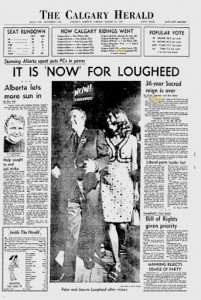
Forty years ago today, Albertans voted to end the 36 year rule of the Social Credit League and let the light shine as Peter Lougheed‘s Progressive Conservatives scored their first majority election victory and Albertans voted to adopt Daylight Savings Time.
The August 30, 1971 election saw the Lougheed Tories edge out Premier Harry Strom‘s Social Credit by a narrow vote (296,934 votes to 262,953 votes) that was not reflected in the number of MLAs each party elected (49 PC MLAs and 25 Social Credit MLAs). The NDP also landed their first solid beachhead in the Assembly with the election of leader Grant Notley in the northern Spirit River-Fairview constituency. The only party leader to not win a seat in the Assembly was Liberal leader Bob Russell, who placed third in St. Albert.
Since that day forty years ago, the PC Party has won nearly every general election with ease. With the exception of the 1993 election, where the Liberals led by former Edmonton Mayor Laurence Decore appeared to snatch defeat from the jaws of victory against rookie Premier Ralph Klein, the PCs have thrown every opposition leader into a meat grinder.
The PCs have not survived as one of the most successful political organizations in Canada by being nice guys. While driven by a vague set of principles, Alberta’s natural governing entity is essentially an amorphous blob on the subject of policy, following trends and public opinion – straddling the ideological centre while appeasing the various corners of its very large political tent. This positioning has allowed the PC Party to appeal to a wide-range of Albertans, who already largely self-identify as “conservative.” Being the sure bet for an election win has also helped the PC Party recruit talented candidates from across the political spectrum and build strong (and well-funded) local organizations across the province.
The PC Party is also ruthless on the subject of keeping its hold on power. As PC members vote select a new leader on September 17, 2011 it may be smart for the leadership candidates to reflect on the historical fact that only one PC leader, Premier Lougheed, was allowed to leave gracefully on his own time. Each leader following Premier Lougheed – Don Getty, Ralph Klein, and Ed Stelmach – were in one way or another shown the door when they appeared to be a threat to the PC Party’s continued political success.
Tomorrow, August 30, 2011, is the fortieth anniversary of the Alberta Progressive Conservative Association’s first election victory. In that election the Alberta PCs, led by Peter Lougheed, defeated the 36-year governing Social Credit League led by Premier Harry Strom, and has been re-elected in each election since. Here is a look back at some of the campaign advertisements published in Alberta newspapers during that monumental election:
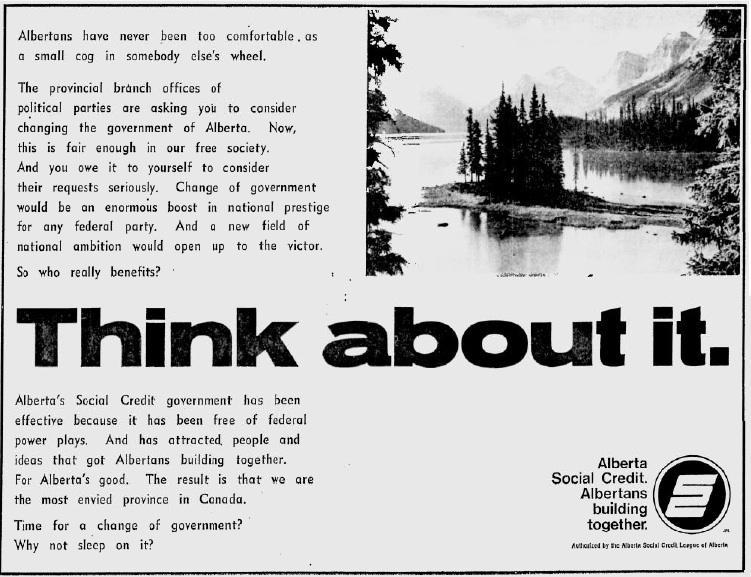


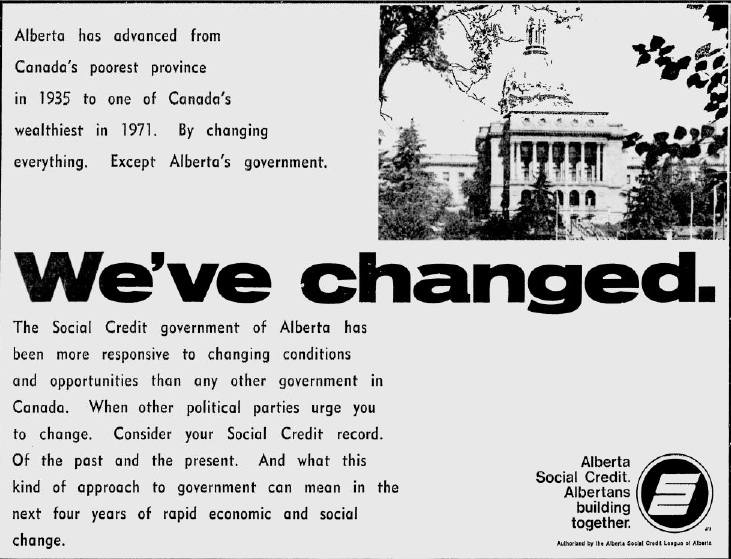

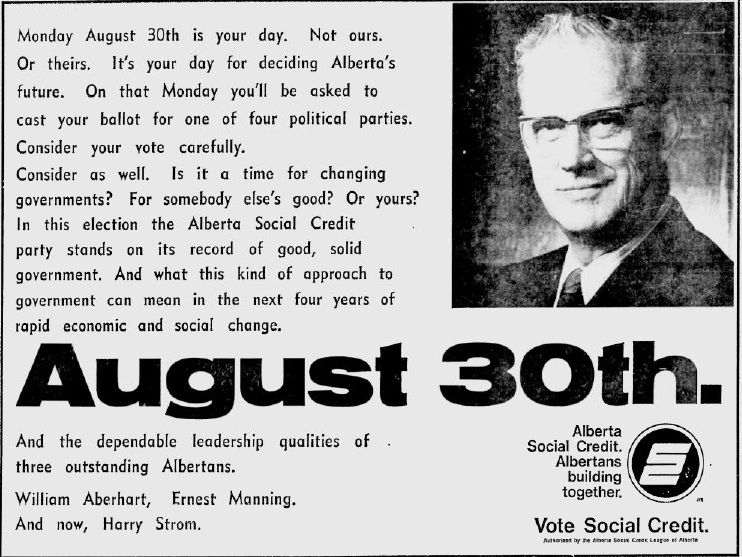




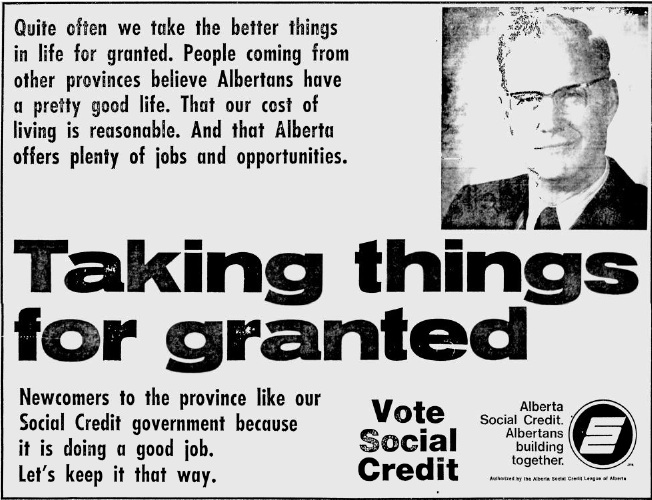
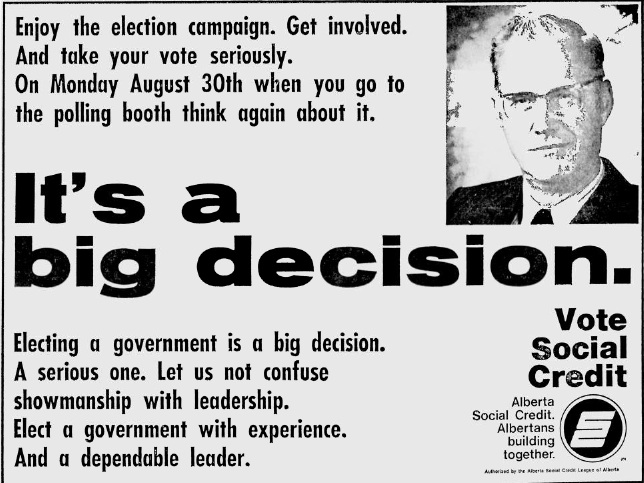

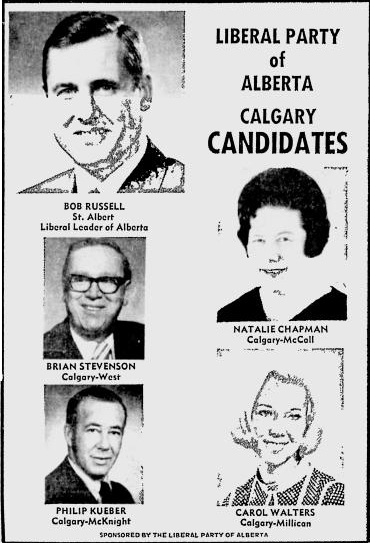

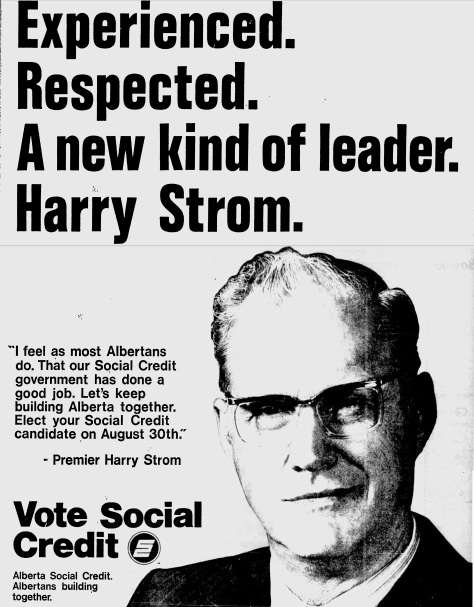
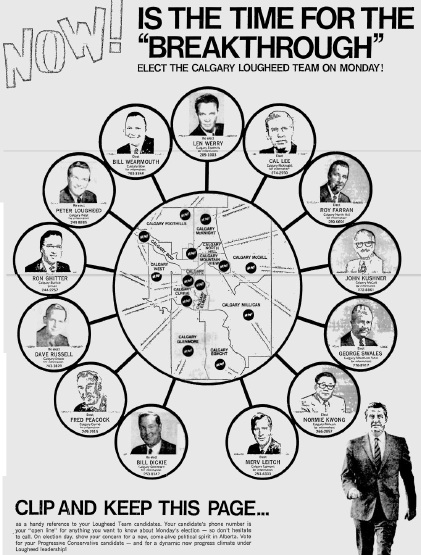

It has been fascinating to watch Premier Ed Stelmach‘s career as Premier culminate towards yesterday’s announcement that he will not lead his party into the next provincial general election. As someone who was too young to remember Don Getty‘s resignation and Ralph Klein‘s accession to the throne, it was certainly an interesting political experience for me to see the entire political life of a Premier for the first time.
It is not a secret that since entering the Office, Premier Stelmach struggled to define his leadership style. Under his Premiership, the general policy direction of his government sometimes appeared to be drifting towards numerous locations at the same time. The Progressive Conservatives have been in office for nearly 40 years and have become a natural governing party that in many ways creates and adopts policy as would a an amorphous blob.
With both his party’s popularity and personal approval rating having drastically dropped since the 2008 election, it would not be surprising to learn that more than a few PC MLAs and cabinet ministers were planning not to seek re-election if there was not a change in leadership. I have also heard that tension between the Premier and Finance Minister Ted Morton, and MLAs and the Premier’s Chief of Staff, Ron Glen, also heavily contributed to yesterday’s announcement.

I had a special relationship with the Premier that began in December 2007 when his lawyers threatened to sue me over my ownership of the URL edstelmach.ca. After forwarding the URL to the wikipedia entry of the last Social Credit Premier Harry Strom, I received a threatening letter from the Premier’s lawyer demanding that I cease and desist (and govern myself accordingly). The Premier may have been insistent that his name was his name, but when push came to shove they backed down (and helped me increase this blog’s readership by at least 500%). Without malice three years later, it turns out that I was closer than I thought with my Premier Strom comparison.
Likeness to Premier Strom aside, it would be unfair to say that Premier Stelmach has not achieved anything while occupying his current office. Always a class act, Calgary Mayor Naheed Nenshi said it well in an interview with the Calgary Herald yesterday:
“Right now I think it’s not time to think about politics. It is time to think about Premier Stelmach’s legacy as a really decent human being and a really dedicated public servant.”
He promised and implemented the long-awaited Lobbyist Registry. His 2010 budget provided a five year commitment to stable funding for Health Care and Education, two departments that had felt the brunt of the budget cuts in the 1990s. His government established the Capital Regional Board, which started a long-overdue armistice that ended the regional turf wars between municipalities in the Edmonton region. His personal commitment to ending homelessness should also not be forgotten, as his government has supported the development and funding of municipal 10 year plans to end homelessness.
Many of these accomplishments have been overshadowed by the decision to raise and then again tinker with the natural resource royalties collected by the provincial government, which angered many in Calgary’s energy sector. The downturn in the economy and the return to deficit budgets also changed how many Albertans viewed the PC government, after years of being told that “deficit budgets were illegal” during Premier Klein’s tenure. The forced merger of the province’s nine regional health authorities into one mega-health authority known as Alberta Health Services also raised serious questions about proper planning and the value of centralization in Health Care. His government’s decision to challenge rural landowners over property rights and the construction of high powered electrical transmission lines also created conflict in areas of the province that had been PC strongholds for decades.
Premier Stelmach’s eventual departure does not automatically save the PC Party from their low support in the polls. The party now needs to select a new leader while facing an organized and well-funded opposition in the form of the Wildrose Alliance, who have leaned heavily on federal Conservative Party organizers to build their party machinery. The Liberals and New Democrats remain competitive in some Edmonton and Calgary ridings and the new Alberta Party announced this week that Calgary-Currie MLA Dave Taylor had become their first MLA.
Although Premier Stelmach will remain leader of the government to oversee the next provincial budget, attention will now be turned toward his potential successors. Finance Minister Morton appears to be the early favourite and could even soon resign his cabinet post to focus on a leadership bid. An immediate Morton coronation could be postponed by the entrance of candidates such as former federal Environment Minister Jim Prentice, Advanced Education Minister Doug Horner, Justice Minister Alison Redford, or Treasury Board President Lloyd Snelgrove. It would also be interesting to see some younger talent, like Housing Minister Jonathan Denis or Battle River-Wainwright MLA Doug Griffiths throw their names in the race.
Regardless of Premier Stelmach’s departure and the leader the members of that Party chooses in the upcoming leadership contest, the big question is whether the PCs be able to redefine themselves as they approach 40 years as our province’s governing party? Will a new PC Party leader be able to satisfy Albertans’ new found appetite for political change?
